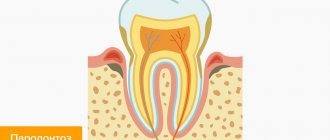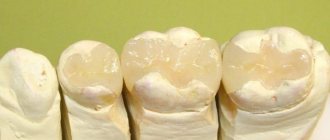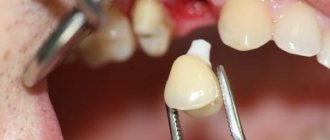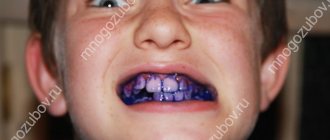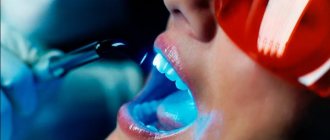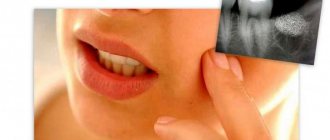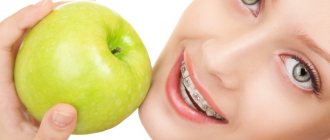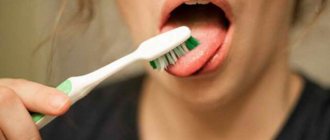Restoring a damaged tooth is a complex work aimed at preserving your dental unit and avoiding prosthetics or implantation. Modern dentistry offers a number of effective methods for treating a damaged tooth, even if only a two-millimeter root remains. In this material we will give answers to the most common questions regarding how to reliably restore a dental unit if it is more than half destroyed.
What teeth can be restored?
In dental practice, it is customary to consider those crowns that are missing more than 50% of their parts as a result of:
- carious lesion;
- mechanical injury;
- the presence of old fillings that do not collapse on their own, but caries develops underneath them;
- depulpation, against which the crown becomes fragile and changes color;
- increased abrasion of dentin, etc.
If you do not seek help from a dentist in time, restoring the unit will be problematic.
What to do if a tooth is overgrown with gum
If the dental crown breaks almost at the very root, there is a risk of it becoming overgrown with gum tissue. A tooth can break for various reasons - mechanical damage, trauma, for example, a strong blow, carious process, etc. Small fragments gradually come out on their own, but the root remains inside the gum. Gum tissue grows, gradually covering the rest of the tooth.
An overgrown root may not bother the patient for a long time. As the pathological process develops, painful sensations appear, the gums become inflamed and swollen. Patients often complain of pain when chewing.
An overgrown root must be removed, as overgrowth is quite dangerous and can cause serious problems:
- Dental disorder.
- Damage to adjacent teeth.
- Inflammation of the gums.
If a crown breaks off, you should consult a doctor as soon as possible. The specialist will assess the complexity of the problem and select a treatment program.
If the tooth is overgrown and the pathological process has spread to the surrounding tissues, the patient will face a rather complicated operation with a long recovery period. The wound may take a long time to heal. A timely visit to the clinic will help avoid this.
Is it possible to restore a damaged tooth?
Yes, you can. But everything will depend on the volume of the lost coronal part and the general condition of the oral cavity.
For restoration, modern dentists use the following two main methods:
- installation of pins (reinforcement) made of fiberglass or titanium;
- introduction of so-called stump inlays.
If more than 50% of the unit is destroyed, and the dentist has doubts that the crown restored with a stump or pin will not withstand the chewing load, a metal-ceramic crown is installed on the stump pin inlay. When restoring teeth, it is mandatory to clean and fill the canals to avoid the development of caries.
Types of rinsing solutions
Rinse solutions
Rinsing the mouth with severe swelling of the gums is ineffective. This method cannot cure hyperplasia, hypertrophied gingivitis, and acute pericoronitis. The use of solutions, infusions, and decoctions makes sense for swelling of the gums, when gums grow on the teeth due to changing teeth, eruption of wisdom teeth, as concomitant therapy after surgery on the gums.
In such cases, decoctions and infusions of herbs that have anti-inflammatory, decongestant, and hemostatic effects will be effective. Decoctions are prepared in a water bath or by boiling. The following medicinal plants are recommended: oak bark, chamomile, calendula, St. John's wort.
Properties of oak bark: antimicrobial, disinfectant, anti-inflammatory.
- 2 tbsp. l. spoons of crushed bark are poured with boiling water (400 ml) and infused in a thermos for 4 hours.
- 2 tbsp. l. pour 2 glasses of cold water, bring to a boil and simmer over low heat for 30 minutes. The resulting broth is filtered, squeezed out, and topped up with boiled water to 400 ml.
Rinse your gums 3-4 times a day with warm broth.
Properties of pharmaceutical chamomile: anti-inflammatory, bactericidal, decongestant. Preparation of the decoction. 2 tbsp. l. dry herbs, pour 1 glass of cold water and place in a water bath. Bring water to a boil, reduce heat to low. In 15 minutes the broth will be ready. Cool to a temperature of 50 degrees, squeeze, add boiled water to 200 ml. Rinse your mouth 4-5 times a day while warm.
Read also: Teeth are cutting, what to do
St. John's wort contains tannins, vitamin C, rutin, and phytoncides. Thanks to this set, it has an anti-inflammatory, antimicrobial, wound-healing effect. The method of preparation and use is the same as for chamomile.
Solutions to relieve gum inflammation:
Chlorophyllipt is an alcohol solution based on eucalyptus extract. Stomatofit contains natural ingredients: chamomile, mint, thyme, calamus root, oak bark. Tantum Verde is a synthetic drug based on Benzydamine hydrochloride, a non-steroidal anti-inflammatory drug. Rinsing with solutions is carried out according to the instructions.
Pathological processes in the periodontal tissues, in which the gums float onto the tooth, are dangerous due to complications. Removal of the enlarged part of the gum is the main method of treatment. The use of medicinal solutions and decoctions helps relieve the symptoms of inflammation, but does not affect the volume of the gums.
If the gums near the wisdom tooth are swollen:
Noticed a mistake? Select it and press Ctrl+Enter to let us know.
Light filling on a pin – what are the advantages of the method?
A post filling is considered a reliable replacement material when a dentist is restoring a fractured unit. A titanium or fiberglass pin is inserted into the root canal, after which the coronal part is restored with a composite material. Among the disadvantages of the method is the potential risk of root fracture, since the pin fails under pressure, as well as shrinkage of the filling and the development of secondary caries under it.
Unfortunately, teeth restored in this way do not last forever. After 3–5 years, the dentist will have to change the filling or, due to global destruction of the crown, perform prosthetics/implantation.
Is implantation possible after tooth root removal?
Yes, of course it is possible. And we at the clinics of the German Implantology Center widely use implantation after tooth root removal. Our conditions allow us to carry out implantation in such cases. And if we can achieve primary stability of the implant, then in 90% of cases
After removal, we immediately install the implant. We have rolled out the technology to perfection and gives excellent results.
Of course, with the exception of wisdom teeth, no implant is placed after their removal.
General recommendations after tooth extraction
– absolutely the same as recommendations after tooth extraction. There are no special features here:
How to restore a damaged tooth?
Treatment of a damaged tooth involves the following steps:
- examination by a dentist and assessment of further “future” damaged teeth;
- restoration of the stump area using a pin or inlay. The dentist treats the canals, strengthens the unit from the inside, thereby providing reliable support for the filling;
- The crown is built up using a composite material. If the work is done efficiently, the tooth can be visually almost indistinguishable from a natural one. The dentist repeats the shape, color and even transparency.
How is the procedure performed?
How is the procedure performed?
Most often, a pin is used to restore a tooth if only the root remains. Procedure steps:
- Using special equipment, saliva is prevented from getting on the problem tooth.
- Cleaning and grinding of the dental cavity from dead tissue, treatment with an antiseptic.
- Introduction of anesthetic.
- Expansion of the root canal to the required size.
- Filling the root cavity with a quick-hardening substance.
- Installation of a dental pin, the model and material of which are selected by the doctor individually.
- A crown or filling is installed on the pin, which quickly hardens under the influence of a laser or ultraviolet light.
However, the recovery procedure is quite expensive, so it is recommended to first find out the full cost of complex treatment. If after the manipulation you feel discomfort (injury to surrounding tissues, unbearable pain, unnatural swelling at the site of the procedure), you should urgently consult a doctor.
How to properly care for restored crowns?
The tooth that was restored by a specialist is no longer as reliable as a healthy one. The attitude towards him should be as gentle and careful as possible. Avoid biting hard foods; do not “test” the composite’s strength by eating dry bread or nuts. If you have restored incisors, avoid biting into hard fruits and vegetables. And remember that the fillings will have to be renewed after a few years.
Doctors at Zuub.rf perform effective restoration of damaged teeth in the smile area, as well as chewing teeth, etc. Experienced specialists will conduct an examination, prepare the crown for further restoration and guarantee the reliability and strength of the “new” tooth, which will not differ from the rest. Sign up for a consultation right now!
If you have the symptoms described in this article, be sure to make an appointment at our clinic.
Don't self-medicate! Even the smallest problem, if not treated correctly, can significantly complicate your life.
By contacting us, you can be sure that:
- Get high-quality and free consultation .
- You will receive the best prices for treatment and the opportunity to receive a special promotional price.
- Only modern equipment and materials will be used.
- You will be treated by professional doctors with many years of experience.
- We offer treatment on credit or in installments. There is also the possibility of obtaining a tax deduction.
- We work seven days a week and without a lunch break, from 9 a.m. to 10 p.m.
+7 (495) 132-02-96
Make an appointment
Saving teeth after the holidays: how to restore freshness to your smile after long feasts
Dentists tell us why New Year's libations and overeating are dangerous for dental health.
Inna Virabova, dental surgeon, Oral-B and Blend-a-med expert, President of the International Dental Association (IDA).
Hidden threat in every bite
New Year's holidays are a magical time of family comfort, warm and sincere meetings over a cup of tea or a glass of red wine, and absolutely doing nothing. The routine in which many of us spend these days cannot but affect the condition of the entire body in general and the oral cavity in particular. When seeing patients after a long weekend, I often hear that there was simply no time to pay attention to thorough oral care, and some even claim that they did it deliberately - it’s “holidays” after all! Therefore, I am no longer surprised when “well-rested” patients notice darkening of their teeth, complain of increased sensitivity and generally poor condition of their teeth and gums, plus, against the background of poor hygiene, old “sores” worsen.
The first reason for darkening of the enamel in this situation is the consumption of coloring foods and drinks, primarily red wine: it can permanently stain tooth tissue in a fairly short time. In a good way, after red wine you need to rinse your mouth with plain water, but hardly anyone thinks about this during a festive feast. Dark pigmented plaque could also appear after drinking large amounts of tea or coffee (especially without milk). Of course, what is a holiday without a cup or two of hot drink with sweets - but this is enough for the radiance of your smile to fade without proper care.
Carbonated drinks, including champagne, without which no New Year is complete, often cause increased sensitivity of teeth and the appearance of cracks in the enamel. In the future, to prevent this, it is better to drink them through a straw.
Fruit juices, pomegranates, tangerines and other citrus fruits are dangerous for teeth due to the acid content in their composition. In addition, fibers and pieces of some fruits sometimes get stuck between teeth - you may not even notice it. And then, if you do not use dental floss regularly, these pieces will remain there for some time, irritating the mucous membrane and provoking the active proliferation of bacteria. Chocolate, caramel, cakes and all kinds of foods high in simple, or fast, carbohydrates and a high glycemic index create ideal conditions for bacteria.
By absorbing and processing sugar, bacteria release acid, which destroys teeth, irritates gums, can cause bleeding, inflammation and, as a result, “loose” teeth. It is enough to brush your teeth poorly several times with such a diet so that microorganisms settle in the uncleaned food debris and sticky plaque, which use these residues as building material for their new “home”, firmly attached to the surface of the tooth - the so-called dental plaque. Within 12 hours, such a plaque absorbs enough calcium from saliva to mineralize, turning into tartar. It is almost impossible to remove it without the help of a dentist. Under the protection of the hard shell of tartar, bacteria can become much more dangerous.
How not to put your teeth in a glass
The New Year is a great time to start taking proper oral care. The first step may be to consult a dentist. Most likely, after long and uncontrolled holidays, your teeth need professional hygiene, which will help get rid of plaque, tartar and prevent the development of caries. This procedure in the dentist’s office will help restore the health of your teeth and gums, protecting you from the risk of gingivitis, caries and their complications.
After professional cleaning, it makes sense to undergo a course of remineralization therapy, during which the dental tissues are saturated with necessary substances. If the dentist does not identify any contraindications (this includes carious cavities, which must be healed in advance), then after this procedure, whitening can be performed. Keep in mind: artificial materials cannot be whitened, so fillings in prominent places will have to be replaced if the whitened teeth turn out to be significantly lighter.
The next step is to maintain the result. When the dentist has completed his task, everything depends on you: only high-quality hygiene, daily care and a responsible attitude towards your own teeth will allow you to maintain the beauty and health of your smile.
Make it a habit to rinse your mouth with warm water after every meal, coloring, carbonated and alcoholic drinks, and also use dental floss. It will help prevent the appearance of dark plaque along the walls of the teeth and relieve you of food debris in the interdental spaces. But it’s better to forget about toothpicks: they are unaesthetic, unhygienic, and the sharp end can easily damage the gums.
I would recommend getting a irrigator and an electric toothbrush with 3D technology, a pressure sensor and a function for determining the cleaning zone. Due to the fact that it has a compact round nozzle, it cleans teeth from all sides. The bristles are rounded at the ends to prevent scratches on the enamel. The pulsating movements of the nozzle loosen plaque, “tear it off” from the surface of the tooth, and the reciprocating rotational movements remove it even from the most inaccessible and narrow areas. Thanks to this technology, the brush fights cervical plaque on the teeth, which most often causes gum inflammation and bleeding. Breath becomes fresh, natural whiteness returns. For prevention, you can periodically use a whitening attachment with a polishing cup in the whitening mode and the gum massage mode, which is available in the Oral-B GENIUS series brushes.
One of the most useful features of these brushes, in my opinion (besides, of course, determining the cleaning zone via a smartphone app), is pressure control. It allows you to regulate the force with which you press on the brush, which will save you from increased tooth sensitivity and gum injury.
Electric toothbrushes can be used not only by adults, but also by children. Manual skills at a young age are not yet very well developed, and oral hygiene must be of especially high quality. Therefore, from the age of 3, you can already use an electric brush, which in a playful way will teach your child how to properly brush his teeth and prevent the development of caries. Moreover, thanks to its slight vibration, the brush perfectly adapts the child to the environment of the dental office, which greatly simplifies the psychological burden of going to the dentist. But remember that regardless of the choice of brush, any brushing of a small child’s teeth should be supervised by parents for the safety and effectiveness of the procedure.
In conclusion, let me remind you that you need to visit the dentist for a preventive examination twice a year, even if there are no complaints. With children, it is better to visit the doctor more often, for example, every 3 months. If you’ve already decided to take care of your health in the new year, then get serious!
Andrey Grigoryants, Candidate of Medical Sciences, Head of the Scientific and Clinical Center for Oral and Maxillofacial Surgery and Dentistry, Oral-B and Blend-a-med expert.
The period of vacations and holidays is wonderful, but in most cases it is accompanied by a disruption of the usual rhythms and healthy lifestyle. When it comes to brushing your teeth, many people lack regularity these days. Junk food, excess consumption of sweets, sour and alcohol and irregular brushing lead to a weakened state of teeth in one to two weeks. A large number of coloring components in food and drinks contribute to a decrease in the whiteness of teeth. Yellow teeth are what usually upsets patients the most. That is why after the holidays it is necessary to pay special attention to the restoration of tooth enamel and oral mucosa. We are used to putting our entire body in order, and our teeth require the same.
First of all, we return to the correct regimen, namely, we brush our teeth in the morning and evening, thus creating a favorable healthy background in the mouth. We use all personal hygiene products: toothbrush, toothpaste, dental floss, irrigator, mouthwash. By the way, during this period, electric toothbrushes with reciprocating technology are especially effective, which not only “restore order” to the oral cavity, but also have a light massage effect on the gums and help whiten teeth safely at home. By restoring health to your teeth, you get an aesthetic bonus: your teeth become lighter and your smile brighter.
